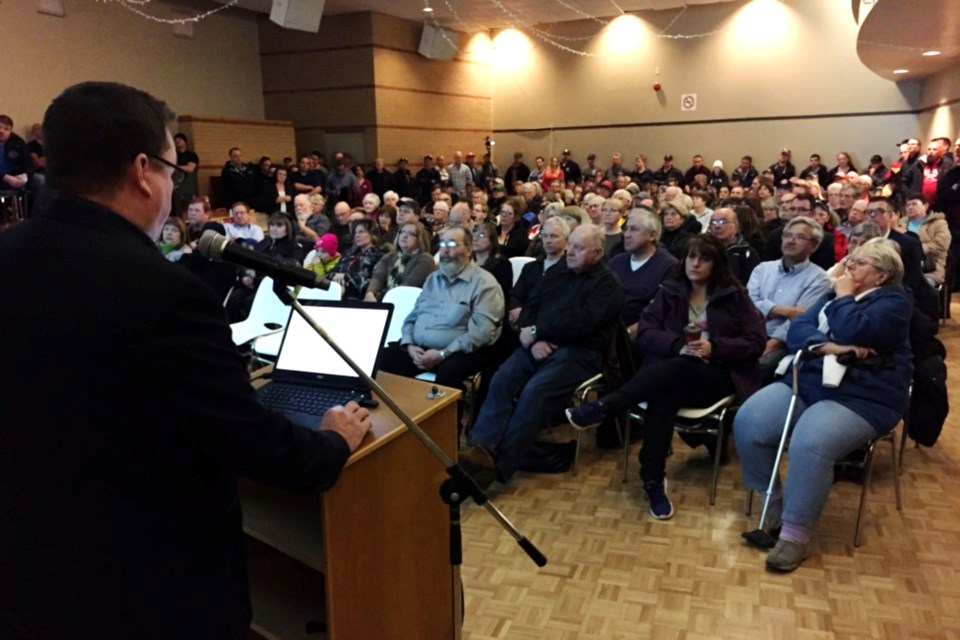With the city poised to delve into another series of public meetings regarding its fire/paramedic infrastructure, it’s worth clarifying how the latest proposal compares to that put forward in 2017.
While the ill-fated 2017 “Fire and Paramedic Services Optimization Final Report” proposed a range of changes to service levels and staffing, the latest report narrows in on buildings alone.
“This report’s not looking at changing the fire delivery service model,” Greater Sudbury Fire Services interim deputy chief Craig Lawrence told Sudbury.com this week.
“It's just contemplating how many stations are required to deliver the current service level. If you're a volunteer in a volunteer area, that stays the same. The only difference is you might be reporting to a different location.”
Lawrence has joined Nathan Melin by filling in as deputy chiefs while Deputy Chief Jesse Oshell is on leave.
While the 2017 report proposed shifting away from volunteer firefighters by adding 58 career members, the new plan doesn’t propose any staff changes.
“Staff reporting to stations that are recommended for consolidation would report to the next-closest location and remain active with the service,” according to a municipal report on the latest proposals. “Existing, ongoing recruitment efforts are not affected by the recommendations in this report and will continue.”
An increased municipal cost came with the 2017 plan, but the financial implications of the latest round of proposals won’t be known until a presentation to city council, which is expected to take place on June 27. The 2017 plan also proposed changes to how taxpayers fund firefighters, which has not been presented in the report currently under consideration.
Although the specifics of fire/paramedic hall relocations and consolidations vary between the 2017 proposal and that currently before city council, both propose a footprint reduction.
The 2017 plan proposed a reduction of fire/paramedic stations from 27 to 17, while the new plan has proposed reducing the current footprint of 24 locations to 15. The new plan proposes:
- Consolidate Skead and Falconbridge into new ideal site for Garson
- Consolidate Val Caron and Hanmer at current site in Val Thérèse
- Consolidate Vermilion Lake into Dowling
- Consolidate Beaver Lake into Whitefish
- Consolidate Wahnapitae and Coniston at new ideal site
- Consolidate Waters, Lively and Copper Cliff at a new location on Anderson Drive in Lively
The new plan also proposes relocating the Minnow Lake station northward to the area of The Kingsway and Falconbridge Road.
If fully implemented, the new recommendations made by Operational Research in Health Ltd. and supplemented by Fire and Paramedic Services Chief Joseph Nicholls would affect response times depending on location. The city’s overall 90th percentile response time would be reduced by an estimated 10 seconds.
The breakdown of proposed fire/paramedic station consolidations and locations in the new plan vary from the 2017 report, which Lawrence said is due to five years passing between studies.
“The station location study is reflective of where we are right now and where we are today,” he said.
While different in approach, both the 2017 plan and the one city council is currently considering share a common goal of tackling the hodgepodge of aging infrastructure the City of Greater Sudbury adopted through amalgamation more than 20 years ago.
The city’s 24 fire/paramedic stations range in age from 17 years of age (Azilda) to 70 (Lively). The average age of the city’s career stations is 43, and the average age of volunteer stations is 50. The life cycle for stations is approximately 50 years.
The controversial 2017 report
While the 2017 “Fire and Paramedic Services Optimization Final Report” welcomed wave after wave of controversy after it was first introduced, the document itself proposed specific changes.
The report (click here for all its associated documents) proposed a “One City One Service” model in which resources “are allocated based on the overall council priority, risk assessment and collective needs.”
It proposed reducing the number of fire/paramedic buildings from 27 to 17 “in locations that are best able to respond to the risks and needs of the entire city.”
Accompanying the reduction in fire halls would have been a reduced reliance on fire trucks, from 73 to 48.
The proposed move would shift staffing from 108 career and 350 volunteer firefighters to 166 and 135, respectively. Increasing career member ranks by 58 members proved particularly controversial due to its cost, with volunteers receiving approximately $3,200 a year compared to full-time firefighters receiving an estimated $125,000 on average.
The city’s elected officials eventually killed the controversial plan during an April 26, 2017, special meeting, at which not a single member of city council supported it.
The optimization plan had been in the works since 2014, when a fire and paramedic tactical plan recommended fire and paramedic services in the city be optimized. The study began in 2015.
A series of public meetings regarding proposed changes to emergency services infrastructure is expected to begin in early April, though times and locations have yet to be announced.
Clarke covers city hall and political affairs for Sudbury.com.
